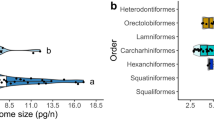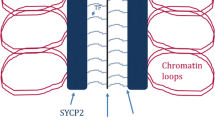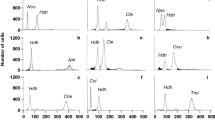Abstract
We investigated the relationship between synaptonemal complex (SC) length and genome size in 18 species of vertebrates from the classes Osteicthyes (bony fish), Reptilia (reptiles), Aves (birds), and Mammalia (mammals). When total SC length was plotted against genome size for all 18 vertebrate species, there did not appear to be a correlation between the two variables. However, when birds were excluded from the data and a linear regression analysis was performed, variation in genome size accounted for approximately 50% of the variation in total SC length (r 2 = 0.47). Dividing the average total SC length for a species by its 4C DNA amount yields the species' SC/DNA ratio. SC/DNA ratios of birds were approximately twice as high as the SC/DNA ratios of reptiles and mammals. Bony fish showed intraclass divergence in SC/DNA ratios. The sunfish (Centrarchidae) had SC/DNA ratios almost as high as those of birds, while the remaining fish in the study had SC/DNA ratios similar to those of reptiles and mammals. These observations indicate that interand intraclass divergence in the relationship between total SC length and genome size has occurred in the vertebrates. Coupled with evidence from the literature, our results also suggest that SC/DNA ratios are positively correlated with crossover frequency.
Similar content being viewed by others
References
Anderson LK, Stack SM, Fox MH, Chuanshan Z (1985) The relationship between genome size and synaptonemal complex length in higher plants.Exp Cell Res 156: 367–378.
Baserga R (1985)The Biology of Cell Reproduction. Cambridge: Harvard University Press, pp 3–33.
Bennett MD, Smith JB (1976) Nuclear DNA amounts in angiosperms.Phil Trans Roy Soc Lond 274: 227–274.
Bojko M (1985) Human meiosis IX. Crossing over and chiasma formation in oocytes.Carlsberg Res Commun 50: 43–72.
Botstein D, Davis RW (1982) Principles and practice of recombinant DNA research with yeast. In: Strathern JN, Jones EW, Broach JR, eds.The Molecular Biology of the Yeast Saccharomyces—Metabolism and Gene Expression. New York: Cold Spring Harbor Laboratory, pp 607–636.
Darzynkiewicz Z, Crissman HA (1990) Preface. In: Darzynkiewicz Z, Crissman HA, eds.Flow Cytometry. San Diego: Academic Press, pp xv-xvii.
den Tonkelaar EM, van Duijn P (1964) Photographic colorimetry as a quantitative cytochemical method. I. Principles and practice of the method.Histochemie 4: 1–9.
Donis-Keller H, Green P, Helms C,et al. (1987) A genetic linkage map of the human genome.Cell 51: 319–337.
Dresser ME, Giroux CN (1988) Meiotic chromosome behavior in spread preparations of yeast.J Cell Biol 106: 567–573.
Gillies CB (1975) Synaptonemal complex and chromosome structure.Annu Rev Genet 9: 91–109.
Gillies CB (1983) Spreading plant synaptonemal complexes for electron microscopy. In: Brandham PB, Bennett MD, eds.Kew Chromosome Conference II. London: George Allen & Unwin, pp 115–122.
Gillies CB, Cowan SK (1985) The pachytene synaptonemal complex of the cat.Genetica 67: 99–107.
Glamann J (1986) Crossing over in the male mouse as analysed by recombination nodules and bars.Carlsberg Res Comm 51: 143–162.
Hartley SE, Horne MT (1984) Chromosome relationships in the genusSalmo.Chromosoma 90: 229–237.
Heller IH, Elliot KAC (1954) Desoxyribonucleic acid content and density in brain and human brain tumors.Can J Biochem Physiol 32: 584–592.
Jagiello G, Fang J-S (1979) Analyses of diplotene chiasma frequencies in mouse oocytes and spermatocytes in relation to ageing and sexual dimorphism.Cytogenet Cell Genet 23: 53–60.
Jagiello G, Duncayen M, Fang J-S, Graffeo J (1974) Cytogenetic observations in mammalian oocytes. In: Pearson PL, Lewis KR, eds.Chromosomes Today, 5. New York: John Wiley & Sons, pp 43–63.
Jones GH, Croft JA (1989) Chromosome pairing and chiasma formation in spermatocytes and oocytes ofDendrocoelom lacteum (Turbellaria, Tricladida); a cytogenetical and ultrastructural study.Heredity 63: 97–106.
Jones GH, Croft JA, Wallace BMN (1983) Synaptonemal complexes in surface spread preparations of Orthopteran spermatocytes. In: Brandham PB, Bennett MD, eds.Kew Chromosome Conference II. London: George Allen & Unwin, pp 123–130.
Jørgensen AL, Bak AL (1981) The length of silver-stained human autosomal pachytene chromosomes.Hum Genet 59: 108–111.
Kaelbling M, Fechheimer NS (1983) Synaptonemal complexes and the chromosome complement of the domestic fowl,Gallus domesticus.Cytogenet Cell Genet 35: 87–92.
Lau Y-F, Arrighi FE, Chuang CR (1977) Studies of the squirrel monkey,Saimiri sciureus, genome II. C-band characterization and DNA replication patterns.Cytogenet Cell Genet 19: 14–25.
Loidl J (1991) Coming to grips with a complex matter—a multidisciplinary approach to the synaptonemal complex.Chromosoma 100: 289–292.
Menten ML, Willms M, Wright WD (1953) Nucleic acid content of splenic lymphocytes in normal and leukemic mice.Cancer Res 13: 729–732.
Mirsky AE, Ris H (1949) Variable and constant components of chromosomes.Nature 163: 666–667.
Mirsky AE, Ris H (1951) The desoxyribonucleic acid content of animal cells and its evolutionary significance.J Gen Physiol 34: 451–462.
Mizen NA, Petermann ML (1952) Nuclei from normal and leukemic mouse spleen. III. The desoxypentosenucleic acid content per nucleus calculated from total cell counts.Cancer Res 12: 727–730.
Mogensen HL (1977) Ultrastructural analysis of female pachynema and the relationship between synaptonemal complex length and crossing-over inZea mays.Carlsberg Res Commun 42: 475–497.
Mortimer RK, Schild D (1982) Genetic map ofSaccharomyces cerevisiae. In: Strathern JN, Jones EW, Broach JR, eds.The Molecular Biology of the Yeast Saccharomyces—Metabolism and Gene Expression. New York: Cold Spring Harbor Laboratory, pp 639–650.
Moses MJ (1968) Synaptonemal complex.Annu Rev Genet 2: 363–412.
Moses MJ, Poorman PA (1984) Synapsis, synaptic adjustment and DNA synthesis in mouse oocytes. In: Bennett MD, Gropp A, Wolf U, eds.Chromosomes Today, 8. London: George Allen & Unwin, pp 90–103.
Moses MJ, Slatton GH, Gambling TM, Starmer CF (1977) Synaptonemal complex karyotyping in spermatocytes of the Chinese hamster (Cricetulus griseus).Chromosoma 60: 345–375.
Ohno S, Atkin NB (1966) Comparative DNA values and chromosome complements of eight species of fishes.Chromosoma 18: 455–466.
Pathak S, van Tuinen P, Merry DE (1982) Heterochromatin, synaptonemal complex, and NOR activity in the somatic and germ cells of a male domestic dog,Canis familiaris (Mammalia, Canidae).Cytogenet Cell Genet 34: 112–118.
Pathak S, Wurster-Hill DH (1977) Distribution of constitutive heterochromatin in carnivores.Cytogenet Cell Genet 18: 245–254.
Pollock DL, Fechheimer NS (1978) The chromosomes of cockerels (Gallus domesticus) during meiosis.Cytogenet Cell Genet 21: 267–281.
Ragland CJ, Gold JR (1989) Genome size variation in the North American sunfish genusLepomis (Pisces: Centrarchidae).Genet Res 53: 173–182.
Rahn MI, Solari AJ (1986) Recombination nodules in the oocytes of the chicken,Gallus domesticus.Cytogenet Cell Genet 43: 187–193.
Rassmussen SW (1977) Chromosome pairing in triploid females ofBombyx mori analyzed by three dimensional reconstructions of synaptonemal complexes.Carlsberg Res Commun 42: 163–197.
Sandritter VW, Müller D, Gensecke O (1960) Ultraviolettmik-rospektrophotometrische messungen des nukleinsäuregehaltes von spermien und diploiden zellen.Acta Histochem 10: 139–154.
Sasaki M, Kodama Y, Hayata I, Yoshida MC (1979) Chromosome markers in 12 inbred strains of the Norway rat,Rattus norvegicus.Cytogenet Cell Genet 23: 231–240.
Schmid M, Enderle E, Schindler D, Schempp W (1989) Chromosome banding and DNA replication patterns in bird karyotypes.Cytogenet Cell Genet 52: 139–146.
Schneider RM, Petermann ML (1950) Nuclei from normal and leukemic mouse spleen I. The isolation of nuclei in neutral medium.Cancer Res 10: 751–754.
Sherman JD, Herickhoff LA, Stack SM (1992) Silver staining two types of meiotic nodules.Genome 35: 907–915.
Sherman JD, Stack SM (1992) Two-dimensional spreads of synaptonemal complexes from solanaceous plants. V. Tomato (Lycopersicon esculentum) karyotype and idiogram.Genome 35: 354–359.
Solari AJ (1980) Synaptonemal complexes and associated structures in microspread human spermatocytes.Chromosoma 81: 315–337.
Solari AJ, Agopian S (1987) Recombination nodules, synaptonemal complexes and heterochromatin in the hemipteranTriatoma infestans.Microscopia Electronica Biol Cell 11: 179–195.
Sparrow AH, Price HJ, Underbrink AG (1972) A survey of DNA content per cell and per chromosome of prokaryotic and eukaryotic organisms. In: Smith HH, Price HJ, Sparrow AH, Studier FW, Yourno JD, eds.Evolution of Genetic Systems. New York: Gordon and Breach, pp 451–494.
Stack SM (1984) Heterochromatin, the synaptonemal complex and crossing over.J Cell Sci 71: 159–176.
Stack SM, Anderson LK, Sherman JD (1989) Chiasmata and recombination nodules inLilium longiflorum.Genome 32: 486–498.
Stock AD (1976) Chromosome banding pattern relationships of hares, rabbits, and pikas (order Lagomorpha)—a phyletic interpretation.Cytogenet Cell Genet 17: 78–88.
Stock AD, Arrighi FE, Stefos K (1974) Chromosome homology in birds: banding patterns of the chromosomes of the domestic chicken, ring-necked dove, and domestic pigeon.Cytogenet Cell Genet 13: 410–418.
Thomson RY, Heagy FC, Hutchinson WC, Davidson JN (1953) The deoxyribonucleic acid content of the rat cell nucleus and its use in expressing the results of tissue analysis, with particular reference to the composition of liver tissue.Biochem J 53: 460–474.
Thorgaard GH (1976) Robertsonian polymorphism and constitutive heterochromatin distribution in chromosomes of the rainbow trout (Salmo gairdneri).Cytogenet Cell Genet 17: 174–184.
Tiersch TR, Chandler RW, Wachtel SS, Elias S (1989) Reference standards for flow cytometry and application in comparative studies of nuclear DNA content.Cytometry 10: 706–710.
Tiersch TR, Wachtel SS (1991) On the evolution of genome size in birds.J Hered 82: 363–368.
Vendrely R (1958) La notion d'espèce a travers quelques données biochimiques récentes et le cycle L.Ann Inst Pasteur 94: 142–166.
Vendrely R, Vendrely C (1953) Arginine and deoxyribonucleic acid content of erythrocyte nuclei and sperms of some species of fishes.Nature 172: 30–31.
Vindeløv LL, Christensen IJ, Nissen NI (1983) Standardization of high-resolution flow cytometric DNA analysis by the simultaneous use of chicken and trout red blood cells as internal reference standards.Cytometry 3: 328–331.
von Wettstein D, Rasmussen SW, Holm PB (1984) The synaptonemal complex in genetic segregation.Annu Rev Genet 18: 331–413.
Wallace BMN, Hultén MA (1985) Meiotic chromosome pairing in the normal human female.Ann Hum Genet 49: 215–226.
Weith A, Traut W (1980) Synaptonemal complexes with associated chromatin in a moth,Ephestia kuehniella Z.Chromasoma 78: 275–291.
Westergaard M, von Wettstein D (1972) The synaptonemal complex.Annu Rev Genet 6: 71–110.
Author information
Authors and Affiliations
Rights and permissions
About this article
Cite this article
Peterson, D.G., Stack, S.M., Healy, J.L. et al. The relationship between synaptonemal complex length and genome size in four vertebrate classes (Osteicthyes, Reptilia, Aves, Mammalia). Chromosome Res 2, 153–162 (1994). https://doi.org/10.1007/BF01553494
Received:
Revised:
Accepted:
Issue Date:
DOI: https://doi.org/10.1007/BF01553494




